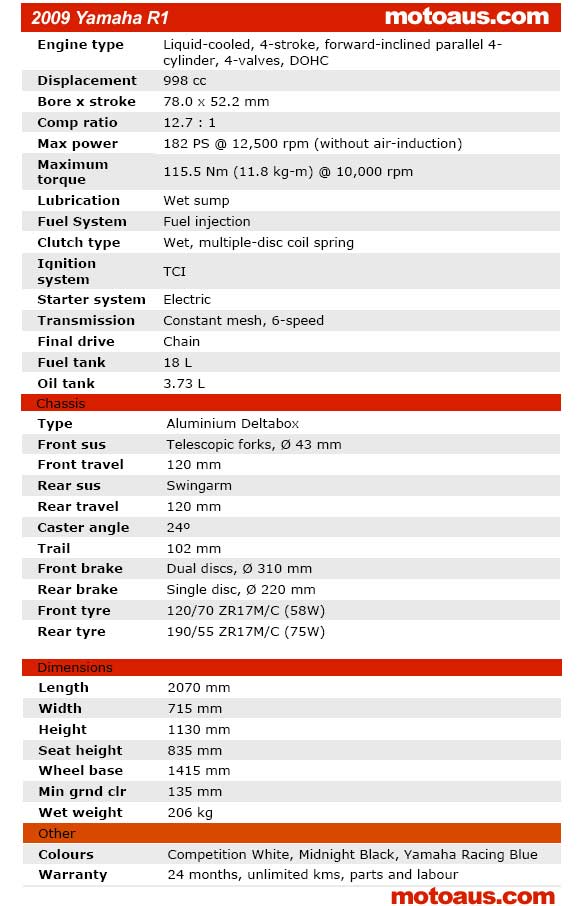 Motoaus Ride Review. We take a look at the 2009 R1 Yamaha.
Motoaus Ride Review. We take a look at the 2009 R1 Yamaha.
2009 Yamaha R1 Review
They say the best friendships are formed from those relationships that start out on rocky ground. This might explain the way I felt about the 2009 Yamaha R1 when I reluctantly returned it back to it’s home at Yamaha’s northern HQ.
I try not to read reviews of bikes before I ride them, so I don’t have pre-existing ideas about what a bike is like before I ride it. It was a bit hard not to soak up information about the new R1 this year – the 2009 model probably made the biggest splash in the market since 1998, when the original R1 lobbed like a tear gas canister in a disco into the sportsbike market.
The reason behind the excitement this time was different, the 2009 version of Yamaha’s icon was sporting a spec sheet torn from the pit garage wall of MotoGP, if you believed the hype.
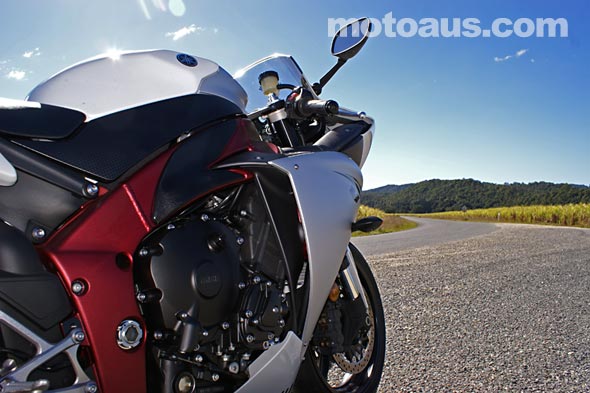
The biggest change – a crank that alters the firing sequence, making the R1 sound like Rossi’s MotoGP M1,and promising a multitude of benefits, not seen since Mick Doohan changed to the mysterious “big bang” engine and ran away with a number of world titles. Knowing a bit about engines, I was expecting a smoother, more torquey version of a 2008 R1, with a pleasant exhaust note thrown in.
Imagine my surprise, when barely minutes into the first ride on the 09, I was struggling with a bike that felt too savage to be used comfortably on the road. A few brisk kilometres down a bumpy Gold Coast hinterland road, and I was getting flashbacks to flailing a YZ490 over whoops with pumped forearms. Bumps in the road while powering on were greeted with a savage snap of power, as any throttle input seemed to be magnified.
More a fan of naked or standard bikes these days – given my advancing years and a late blooming maturity that has seen the urge to overtake the exhaust note diminish – I was less than impressed at how much effort was required to keep this snarling monster from overwhelming my control.

The reason for this lay in a number of acronyms, usually found in abundance on supersport bikes, like Yamaha’s YCC-T, the fly by wire throttle system. My core problem actually lay with another, known as RTFM. This one refers to a new user of a product not making the effort to “read the users manual”.
Had I done that, I would have known in advance that the recommended setting on the right switch block mode switch should have been on “Standard” mode – not “A”mode. Unlike other brands, where A is full power, and B or C is a softer less powerful mode, controlled by ignition or fuelling map, the 09 R1 modes appear to mainly relate to how the “fly by wire” throttle attacks the butterflies when you twist the grip.
And in the R1’s case, “A” mode grabs a virtual fistful of power, with minimal hand movement. Now this may be fine on a smooth racetrack, or even on the freeway when dispensing with that annoying Nissan GTR, but threading my way through a twisting, bumpy, and decidedly damp looking back road, was causing me to question my manhood. Because this quick throttle was linked to the snappiest, torqueist beast of a 1000cc motor I’ve ridden.

It idles like a hoon’s Monaro, and barks like an open pipe V-Max on throttle. And off the throttle – booming and crackling as you de-accelerate into a corner – I could almost imagine flames popping from the twin tailpipes, just like Ben Spies.
I retreated, slinking back home carefully, avoiding any further attempts to emulate Ben or Jorge.
The next time I rolled it out of the garage, I had gained sufficient wisdom to put the bike in “Standard” mode. Immediately it was a changed machine. Gone was my throttle control issues, replaced with a beautifully fueled controllable surge of the promised 180 crank horsepower. Winding the throttle to full saw it howl all the way up to its 13000 odd rev limiter, the rear wheel doing most of the major contact duties with the road.
I’d also since read a few reviews from both press and layman, and discovered that some seemed to think this new engine had robbed the bike of top end power, making it “slower” than it’s competition. I’d like to clarify right now my thinking on this. If you honestly think you will be using full throttle, at full revs, on this bike, for more than few brief seconds at a time on public roads, you are a dreamer.
With a twist of the right wrist, this 180hp bike – like most 1000 cc super sport machines – fires its way through first and second, front wheel in the air, and hits around 180km/h as it bumps the rev limiter. In 2nd gear. Even first gear can get you free bike storage at the local police holding yards.
So while it’s good to fill several pages of a bike test with proclamations about racetrack performance, it’s pretty much academic for the majority of us. Even a hard charging track day regular, isn’t going to be at a disadvantage on any of the current 1000cc supersporters. At this level, only the rider will be making any major differences in performance.

So my comments on this bike aren’t really relevant to any A Grade racers that are considering purchasing one either. This is about your road registered, Sunday road ride, maybe work and back rider. And for this, I think Yamaha have hit a winner. You see this is the first Japanese sport inline 4 I’ve ridden that has evoked the pleasure and thrill of the often talked about V-twin low end drive, and the raw goodness of a race tuned engine.
Add an orchestra of mechanical sounds from the primary drive and transmission and even riding at the speed limit becomes pleasurable. That is not to say the bike isn’t a formidable racetrack weapon, please ask Ben Spies how his World Superbike R1 is working out for him so far this year.
But I know only too well I can’t be hitting 280 km/h on the road, nor running this weapon through all the gears on full noise. Not too often at least. So while I’m running about at a more sensible pace, those other qualities are what sets this bike apart.
A fantastic exhaust and intake noise, even at idle. Check
Instant throttle response. Check.
Great drive from 4 thousand revs to redline. Check.
Nimble, but stable handling. Check.
Powerful, but not grabby brakes. Check.
 After the mode switch lesson had been learned, I set to work putting a decent amount of kilometres on the white and silver rocket. I was impressed with the ergos. It didn’t feel as cramped as I’d expected, and was even bearable on a 100 kilometre freeway run in slow traffic, a task I usually dread on a sportsbike. Some heat through the seat was felt from the mufflers, but nothing too unpleasant.
After the mode switch lesson had been learned, I set to work putting a decent amount of kilometres on the white and silver rocket. I was impressed with the ergos. It didn’t feel as cramped as I’d expected, and was even bearable on a 100 kilometre freeway run in slow traffic, a task I usually dread on a sportsbike. Some heat through the seat was felt from the mufflers, but nothing too unpleasant.
But once out in the mountain roads that beckon Gold Coasters, I found almost nothing to dislike. The handling is impeccable, neither slow steering, nor falling into corners, it went where it was pointed. Change of direction needed minimal input, and even hard on the power, exiting tight bumpy corners, not once did it shake its head, or feel like it might.
Brakes were a one finger operation on the road, and very progressive. Down shifting was helped by an almost hidden slipper clutch effect. But again, the stand out was the motor. I could care less what this thing reads on a dyno, whatever blend of firing sequence, stroke, and fuel, valve and ignition timing Yamaha used, it is near on perfect. Not perfect as in smooth, perfect as in “how good is this!”
It literally barks out of a corner when heavy throttle is used, accelerates, the horizon blurs and the noise sounds even better. It never gave me any heart skipping moments, despite some less than sensible corner exit strategies.
The R1 is loaded with state of the art components: magnesium subframe, titanium valves and pipes, separate damping and compression fork legs, six piston calipers.
Throw in a load of technology, like the variable length intake rams, fly by wire throttle, electronic steering damper, combined with a fantastic build quality, and its hard to find reasons to not own one if you are in the market for a sports bike.
As for the rest of it, no point discussing styling too much, too subjective. I liked the look of it, and although I had a particular fondness for a black/matt black version, I actually got used to our bike’s scheme, even with its red frame.
The headlights drew the most comment, this year they are a pair of bulbous projector lamps, with high and low beam altered by the clever use of a moving shield inside the light, rather than two separate beams. The space next to the lights is now taken up by hungry ram-air mouths.
Instruments feature everything you could want, with the exception of a fuel gauge, one of my personal must haves these days. It did have a low fuel light, which comes on with about 3 litres of the tanks 18 litre capacity left and a readout with distance travelled on low fuel. Dominated by an analogue tacho and a large shift light, the pod has a digital speed readout and the usual lap timers, trip meters and gear position indicator. Average and instant fuel usage was covered, with a best of about 6 litres per 100 kms shown when cruising.
A nifty small bar indicator showed how much throttle opening you had dialled in, needless to say it was a bit hard to see if you had full throttle in first.
Under the tiny pillion seat is a mini storage space, but the tool kit requires unbolting the front seat to get at. Everywhere you look on this bike, the detail and engineering is obvious, from the adjustable foot peg positions, to the lack of wiring mess behind the fairing. Very impressive.
Performance
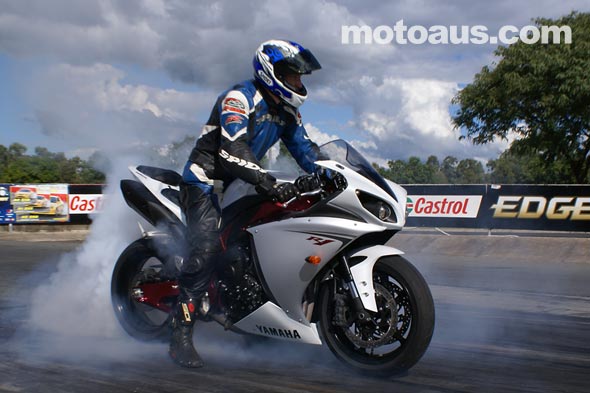
We would have liked to have run the R1 at the drag strip, as dynos can lie and circuit lap times depend on rider talent. A drag strip is a perfect indicator as to how much horsepower, and how usable it is. However Yamaha didn’t want us to use this particular machine, so we can only guess what our resident test pilot Rebecca would have run on the bike. We would have been expecting low tens or high nines from it, given Bec’s performance on other bikes.
Luckily though, we can tell you how the new R1 performs on the dragstrip, thanks to Brian from the Brisbane Bikers website. Brian recently made the switch to a new 09 R1, after a stint on a K6 GSX-R. After a lot of runs at the popular “Shootouts” run at the Willowbank drag strip here in Queensland, Brian had managed a best of 10.19 seconds on his mildly modified, but street ridden Gixxer, a model widely considered to be the fastest of the 1000s on the drag strip. While clearly a handy rider, Brian is neither jockey size, nor a seasoned drag racer.

The first outing on the R1 however, saw his very first run return a 10.86 second time, then progressing to the highlight of the day on his last run, a 10.18 at 141mph, bettering his best ever GSX-R time on the first outing with a dead standard R1.
Over the Nullarbor, regular Perth drag racer Reg McCallum took another stock 09 banger, and with nothing more than the drag racer’s favourite trick of lowering the bike several inches to reduce wheelies, belted out a jaw dropping 9.72 second run. This would appear to dispel any doubts that the R1 can’t deliver the stomp when needed.
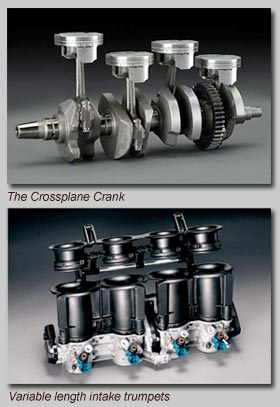 The Crank.
The Crank.
There’s plenty of descriptions on the web, and in print, as to the reason this new motor sounds different. But in case you haven’t grasped it, here’s a simple explanation.
The outgoing R1 model – and all the other manufacturer’s 1000 supersport bikes – use a crank that puts two pistons at the top, when the other two are at the bottom.
This means that every revolution, you have four pistons stopping and changing direction every revolution, with one of the cylinders firing every revolution.
The new Yamaha crank now “twists” that configuration, so this doesn’t occur, with the piston position and firing sequence altered to the irregular beat that gives the bike its distinctive sound.
This causes a change in the way the engine produces and delivers torque, the twisting force that is responsible for the horsepower.
Get it? Didn’t think so… so we have included a video from Yamaha to help explain it.
If that hasn’t helped any, perhaps just relishing the V-Twin meets V4 sound it produces, as being the major benefit you can appreciate.
For the obsessive, new specs include bigger 78mm pistons, with a short 52.2mm stroke. The bores are ceramic composite plated, and the forged alloy pistons squeeze the intake charge against titanium valves, 4 per cylinder, to a 12.7 compression ratio.
The Chassis.
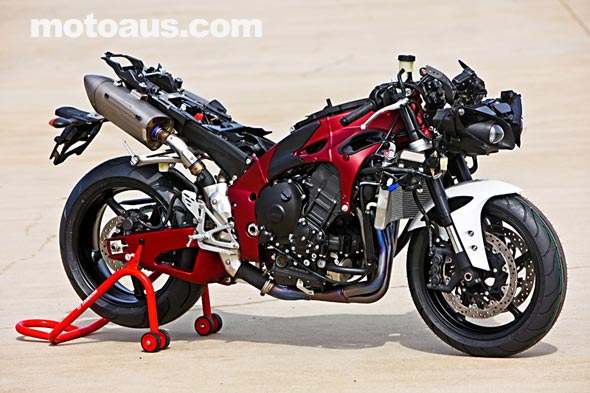
All new for 2009, and retaining the “deltabox” description, the R1’s massive alloy frame has undergone a major rework, with Yamaha mentioning both less and more rigidity in various locations.
According to the marketing info, the new frame uses different types of aluminium to achieve this desired balance of rigidity. Gravity cast parts are used for some parts of the frame, while others are made from die-cast aluminium which allows the use of thinner walls. Parts for the inner tank rail are made from extruded aluminium, and the rear subframe is now made from lightweight magnesium.
Much work was also focused on compacting and centralising mass, including dropping the bottom of the fuel tank deep into the frame recess, to lower the weight of the fuel carried. The swing-arm didn’t escape the rework, being longer, lighter and pivoting closer to the drive sprocket.
Up front, another major feature is the 43 mm forks, with the damping features now separated to each side. Compression damping now lives in the left fork on its own, with brother rebound moving to the right hand fork. I’m no suspension guru, but I can see how this could make each function less of a compromise than when both were combined in each leg.
Front brakes are 310mm, lighter than last years, with four pad, six piston calipers.
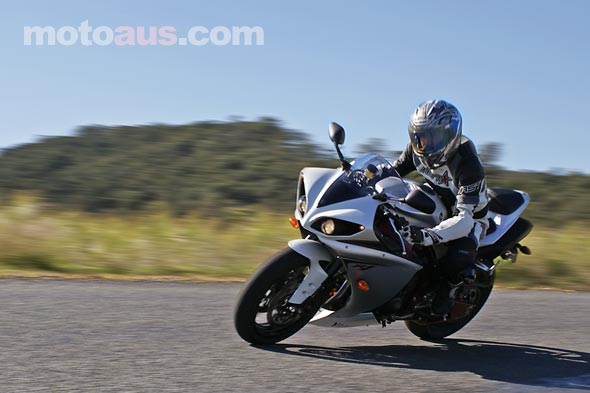
Conclusion
Apart from my initial shock when attempting to punt the R1 hard on a bumpy damp road with the mode switch set on a throttle mashing “A”, I really couldn’t find anything to dislike about the 2009 Yamaha R1. And even the “A” mode didn’t seem as harsh after I’d got more used to the bike.
Although I’m probably not really the ideal sport-bike buying demographic, having grown a little tired of hunching forward looking down at the road, this is one supersport bike I would actually consider. Unless Yamaha are so kind as to make a naked FZ1 version, which I think would be one hell of a bike.
But the R1 needs to be ridden to appreciate it, it almost defies description. And even if you aren’t in the market for another bike at the moment, don’t knock back a test ride on one, they really are special.
While a 180 horsepower supersport bike is far from ideal for all situations, I imagine those considering purchasing this class of machine already know that. Is it the best track bike? I don’t know, or care. Whilst fun to debate at the pub, or in a web forum, race results will probably be the judge of that, not a bunch of journos.
Either way, it won’t bother the majority of proud new R1 owners, who will delight every time they open the throttle and hear that glorious sound.
Ups
That engine
Sweet handling
Not so cramped.
Downs
Using A mode on the road
Specifications
